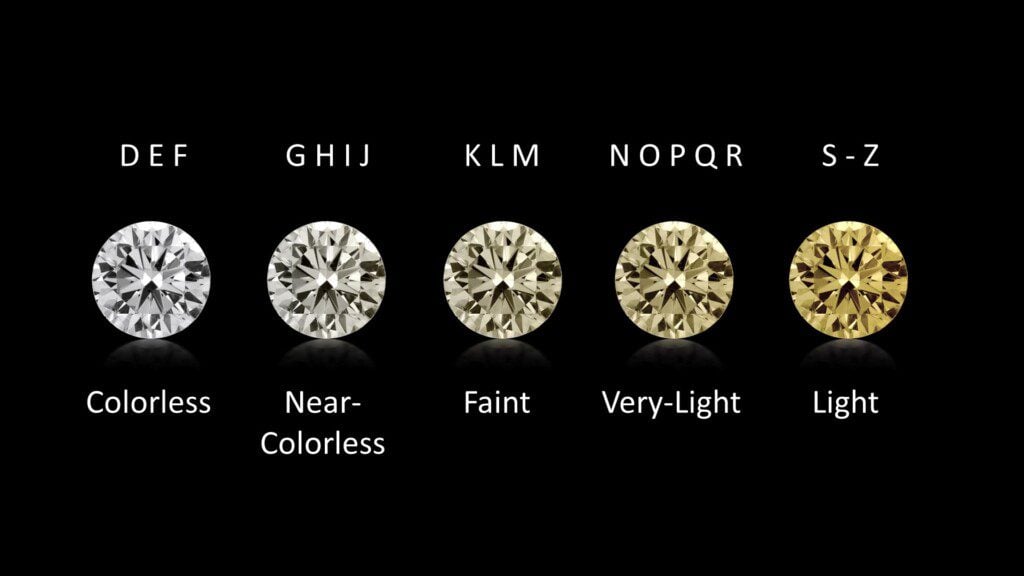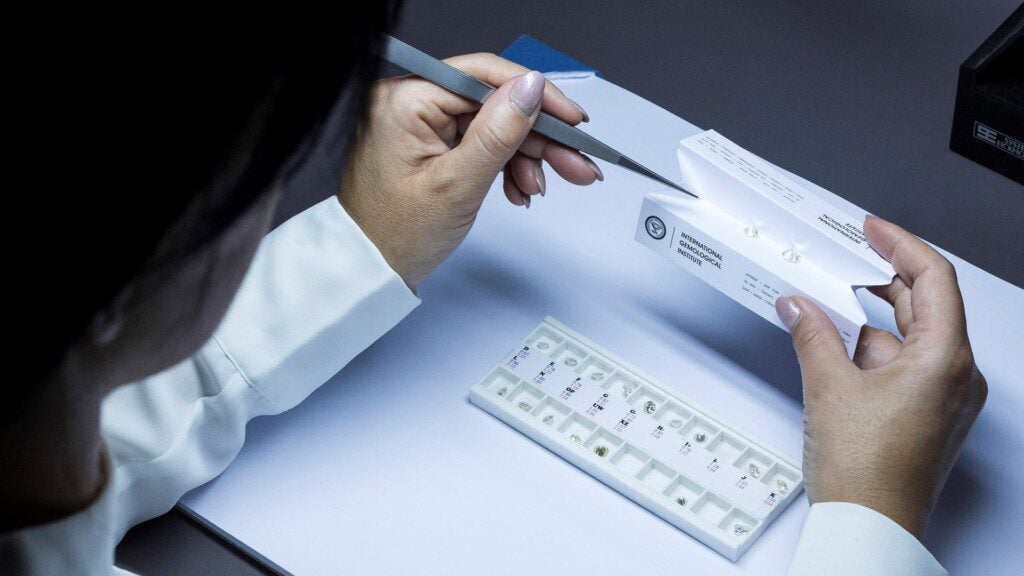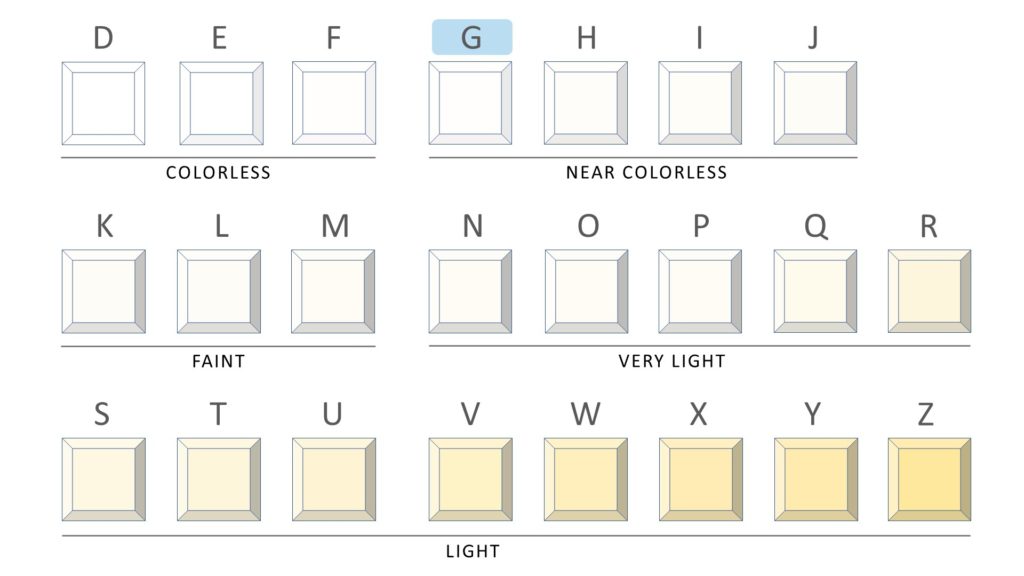How Are Diamonds Made? Natural vs Lab-Created Explained
Two Paths, One Diamond Not all diamonds come from the same place — but they all start the same way. Pure carbon, crystalized under immense pressure and heat. Whether it…
G Color Diamond – Basics
A G color diamond sits at the top of the near colorless range, at the border of colorless. It does not command the premium of colorless diamonds, yet remains extremely white.
PriceScope Pointer: A difference of 2-3 color grades is hard to detect unless you hold the diamonds next to each other. The most purchased diamond colors are graded F-G-H or I, set in white gold or platinum.
Before going on: Check out the PriceScope Diamond Buying Guide
Diamond color is typically graded on a scale descending from D, which means no hint of color, to Z, which means light yellow or light brown.
A G color diamond is high on this scale, in a range described as “near colorless” by gemologists which includes G, H, I and J colors. There are only 3 higher color grades, while there are 19 grades lower than a G color diamond.

Considering its position in the scale, a grader giving a diamond G color is really describing an absence of color: Most of the world’s diamonds have some traces of yellow or brown, caused by chemicals in the earth where they formed. Diamonds with stronger levels of yellow and brown, as well as colors other than yellow or brown are categorized as fancy colored diamonds and graded using a different scale.
Wondering which of the many diamond colors is best for you? Our elite list of vetted vendors like Whiteflash and James Allen are experts at listening and helping you determine which combo of the 4Cs is perfect for you - and nicely in budget. Contact Us and get help today.
G color diamonds are some of the most popular choices, primarily because they remain white without commanding the premium of the colorless range. The most purchased diamond colors are graded F-G-H or I, set in white gold or platinum. A difference of 2-3 color grades is hard to detect unless the diamonds are held next to each other and directly compared.
Unless comparing a G color diamond with a higher color, side by side, most people will not detect tint in a G color diamond. The only exception might be a G color diamond with medium or stronger fluorescence when exposed to ultraviolet light. When excited, any visible tint will be the same color as the fluorescence.
Diamond color is analyzed with the stone in the upside-down position, analyzed from the side. This is done because three factors may influence diamond color appearance when seen from the top: The diamond’s shape, the way it was cut, and the presence of fluorescence.

As it relates to G color:
Check out our section on color evaluation for advice and information on which cuts show less color, depending on shape, and precious metal colors we recommend.
A G color diamond will not sparkle better than a diamond with lower color. A diamond’s observable brightness, fire, sparkle, and contrast are all attributable to its cut-quality. A diamond’s optical properties are not influenced by its color grade, except for variance in spectral absorption minutia which is rarely relevant.
If you are seeing a color G diamond which is inexplicably low priced it could have to do with a subtle or not-so-subtle brown, grey or green undertone which influences overall diamond color appearance. Such tint may not be disclosed on the laboratory grading report but are usually disclosed among wholesalers. Read our section on diamond color analysis for information on avoiding this issue.
PriceScope’s 1-5 star ratings are categorical comparisons with the most thorough, consumer-focused online diamond and jewelry vendors, in categories, we believe reflect our experienced consumer community’s values. Check out PriceScope Jeweler Reviews.
The internationally accepted grading scale and terminology for diamond color in the normal range consists of 23 grading levels. Grading is performed with the diamond upside down. Color G diamonds stand at the highest end of the near colorless range, just below the colorless border.

If you’re looking to buy loose diamonds online, use our special tools to reveal the best cut quality diamonds! Start your diamond search and choose from over a million loose diamonds for sale. Use our filters to find either natural or lab diamonds, as well as fancy color diamonds.
While the descriptive scale above is universally applied, standards can vary between individuals and organizations that decide a diamond has G color.
Variance between reputable graders and organizations may be attributable to standard deviation. Color and clarity judgments are matters of opinion and diamonds often sit on the border of two grades. The only time this becomes an issue is when a buyer and seller disagree about which set of grades establish the diamond’s value.
Intentional over grading has been a historic issue in the diamond trade. Over grading is a willingness to purposely deviate from internationally accepted standards to inflate the perceived value of a diamond. Certain locations of the EGL (now closed) became infamous for over-grading loose diamonds, by 3-4 grades in some cases, permitting unscrupulous sellers to overcharge consumers.
Under grading occurs when a jeweler examines a diamond and claims it was over graded to create fear-based doubts in the diamond owner’s mind. The most frequent example of under grading is when one jeweler implies a consumer overpaid a competing jeweler, hoping the consumer will return the diamond and purchase there, instead.
Get quick answers to any question now: Ask our community of unbiased independent helpers.

Retail Diamond Prices Chart Updated Monthly.

Two Paths, One Diamond Not all diamonds come from the same place — but they all start the same way. Pure carbon, crystalized under immense pressure and heat. Whether it…
A Wedding Ring as Unique as Your Love Finding the right wedding ring isn’t just about diamonds or gold – it’s about finding the one that feels right. With hundreds…
So, you’re thinking about lab-grown diamonds? Smart move. They’re just as sparkly as the natural kind but usually cost less. But where do you actually go to buy them? It…

Want to stay updated on the most recent blogs, forum posts, and educational articles? Sign up for Bling News, PriceScope’s weekly newsletter.